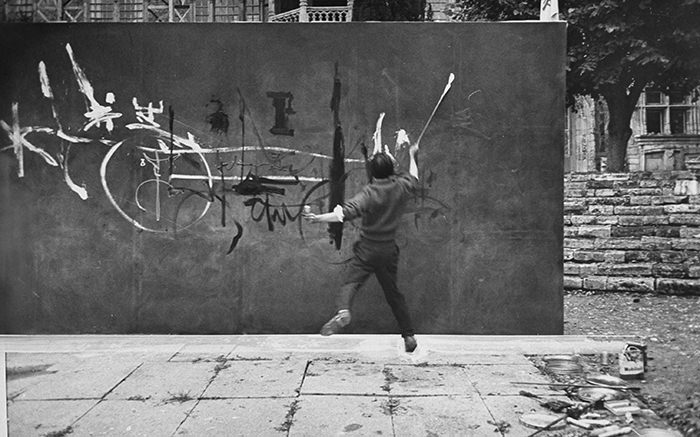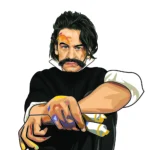Georges Mathieu, the inventor of performance art
Reading the Wikipedia page on performance art, one can wonder why, while there is a (too) short mention of Japan’s Gutai movement, who undeniably anticipated performance art, there is absolutely no mention of Georges Mathieu, the founder of Lyrical Abstraction (the European equivalent of Abstract Expressionism) who inspired Gutai (Mathieu and Pollock are the two artists referred to in Gutai’s manifesto of 1956), who inspired Yves Klein (who was a friend of Mathieu and fellow royalist) and who inspired the Viennese Actionists (Mathieu painted a 6 x 2.5 meter artwork at the Fleischmarkt Theater, the avant-garde theatre and home of the Viennese Actionists).
Art historian Kristine Stiles states, in an article titled “Painting, photography, performance: the case of Georges Mathieu” for the exhibition catalogue of Georges Mathieu’s retrospective at the Galerie du Jeu de Paume in Paris in 2002: “Yves Klein saw in him a guide and one of his royalist peers. The famous Saut dans le vide (1960), with which Klein documented through photography a leap into the unique, spontaneous and dangerous space, testifies to his debt to Mathieu. But Klein’s debt to his mentor is also conceptual and intellectual. Klein’s interest in danger, impulsiveness of gesture, speed and improvisation, which he expressed, among other things, through his lively brushes, echoes Mathieu’s approach. The Viennese Actionists also recognized Mathieu, making his performance on April 2, 1959 in Vienna at the Theater am Fleischmarkt an important factor in their decision to devote themselves to action.”
Mathieu was the first to organize performances and happenings, as early as in 1954 he invites a small crowd of journalists and amateurs to see the live painting of one of his most famous paintings: Les Capétiens partout!, a 6-meter long artwork that he executes in an hour and twenty minutes. In May, 1956, in front of around 2,000 people at the Théâtre de la Ville – Sarah-Bernhardt, on the Night of Poetry, to action paint a huge canvas measuring twelve by four meters, using up to 800 paint tubes. In 1957, Georges Mathieu went to Japan, he executed in Tokyo 21 canvasses in three days including an 8- and a 15-meter fresco, painted in a very short time in front of a large crowd, then in Osaka, he painted in public on the roof of the Daimaru, dressed in a kimono—he wishes to “reintroduce the notion of play into art and culture.” (More details and photographs are available online.) In 1959, he painted Le Massacre de la Saint-Barthélemy under the eyes of TV cameras in Paris, while jazz drummer Kenny Clarke was soloing next to the canvas.
But then why this glaring omission? Kristine Stiles has an answer to it (from the same article): “Why was Mathieu’s contribution to art history (and in particular to performance history) neglected at the time? Why did his theoretical writings fall into oblivion? The negative reaction of American critics to Mathieu’s work seems to me to refer to the old obsession with exhibitionism in the United States, especially the one captured by photography and published in mainstream magazines such as Time. That he was rich, eccentric, and aristocratic in essence, and showed it, did little to help him in the puritan climate of the time. In Europe, some artists linked to the political left rejected Mathieu because of his royalist convictions. This would have been understandable if Yves Klein’s royalism had changed the reception he received from the avant-garde.”
Even though he did not use the word “performance” to describe his art, which is logical as there was no previous reference, in his books Mathieu explained he was placing the work of art “at the crossroads of the object, the act, and the behavior”. According to him there had to be an object, a resulting work of art, for instance a painting, and he would later reject the purely conceptual and more recent versions of performance art. Nonetheless, the act and behavior aspects of this trilogy clearly relate to performance art, therefore he did not only anticipate performance art, he theorized and executed the earliest version of it.






